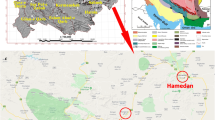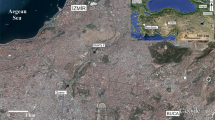Abstract
The goal of the study was to investigate the quality of the four different types of rocks obtained from three different quarries used as armour stones at the Güzelbahçe (İzmir-Turkey) project and to compare the findings against the observed field performance (after being in service between 2015 and 2019). The intent was to demonstrate the importance of initial characterization of the rocks before they are selected to be used in a given project and to examine the suitability of the existing classification methods to properly capture the observed field performance of the stones that may have complex geological make-up. Classification of all of these stones were evaluated in great detail both based on CIRIA/CUR and RERS classification methods. The findings were then compared with the classifications based on durability assessments from laboratory tests. The results from these evaluations indicated that if the selected stones have complex geological make-up, the classifications obtained from CIRIA/CUR and RERS may not be sufficient enough to identify the suitability of the stones. The results showed the importance of careful evaluations and the benefits of combining the results from all of the available classification methods when making decisions.








Similar content being viewed by others
References
Aboubacar MH (2018) The investigation of the quality of armourstones used in rubble mound breakwater (Güzelbahçe). Msc Thesis (in Turkish), Dokuz Eylül University, Graduate School of Natural and Applied Sciences, İzmir
ASTM D 3967 (2008) Standard test method for splitting tensile strength of intact rock core specimens. ASTM International, West Conshohocken. https://doi.org/10.1520/D3967-08
ASTM D 5313 (2004) Standard test method for evaluation of durability of rock for erosion control under wetting and drying conditions. https://doi.org/10.1520/D5313-04
ASTM D 5731 (2008) Standard test method for determination of the point load strength index of rock and application to rock strength classification. ASTM International, West Conshohocken. https://doi.org/10.1520/D5731-16
ASTM D 6473 (2015) Standard test method for specific gravity and absorption of rock for erosion control. ASTM International, West Conshohocken. https://doi.org/10.1520/D6473-15
Bell FG (2007) Engineering geology. 2nd edn. Waltham
BS-EN 12371 (2010) Natural stone test method. Determination of frost resistance
BS-EN 14157 (2004) Natural stones, determination of abrasion resistance, method A, wide wheel abrasion test and method B, Bohme abrasion test
Calcaterra D, Cappelletti P, Langella A, Colella A, Gennaro M (2004) The ornamental stones of Caserta province: the Campanian Ignimbrite in the medieval architecture of Casertavecchia. J Cult Heritage 5:137–148. https://doi.org/10.1016/j.culher.2003.08.003
CIRIA, CUR, CETMEF (2007) The rock manual, the use of rock in hydraulic engineering, 2nd edn. CRIA, London, p C683
Emre Ö, Duman TY, Özalp S, Şaroğlu F, Olgun Ş, Elmacı H, Çan T (2018) Active fault database of Turkey. Bull Earthq Eng 16:3229–3275. https://doi.org/10.1007/s10518-016-0041-2
EN 13383-1 (2002) European Committee for Standardization. Harmonised standard for armour stone Part 1: Specification
Erdoğan B (1990) Tectonic relations between İzmir–Ankara Zone and Karaburun belt. Bull Miner Res Explor Turkey 111:1–20
Erickson RL (1993) Evaluation of limestone and dolomite armor stone durability from observation in Great Lakes Region. In: McElroy CD, Lienhart (eds) Rock for Erosion Control. American Society for Testing and Materials, ASTM STP 1177-EB, Philadelphia, pp 88–93. https://doi.org/978-0-8031-5232-8
Fookes PJ, Gourley CS, Ohikere C (1988) Rock weathering in engineering time. Quat J Eng Geol Hydrogeol 21:33–57. https://doi.org/10.1144/GSL.QJEG.1988.021.01.03
Gamble JC (1971) Durability-plasticity classification of shales and other argillaceous rocks. PhD thesis, University of Illinois at Urbana-Champaign
Hudson JA, Priest SD (1983) Discontinuity frequency in rock masses. Int J Rock Mech Min Sci Geomech Abstr 20:73–89. https://doi.org/10.1016/0148-9062(83)90329-7
ISRM (2007) The complete ISRM suggested methods for rock characterization, testing and monitoring: 1974–2006. In: Ulusay R, Hudson JA (eds) Suggested methods prepared by the commission on testing methods. International Society for Rock Mechanics (ISRM), Ankara
Jefferson DP (1993) Building stone: the geological dimension. Quat J Eng Geol Hydrogeol 26:305–319. https://doi.org/10.1144/GSL.QJEGH.1993.026.004.06
Keller RJ (2005) Further Design Considerations. In: Guidelines for the Design of River Bank stability and Protection Using RIP-RAP. pp 15–19. http://www.toolkit.net.au/riprap.
Knöfel DK, Hoffman D, Snethlage R (1987) Physico–chemical weathering reactions as a formulary for time-lapsing ageing tests. Mater Struct 20:127–145. https://doi.org/10.1007/BF02472748
LeMaitre RW (2002) Igneous rocks—a classification and glossary of terms (recommendations of the IUGS subcommission on the Systematics of Igneous Rocks), 2nd edn. Cambridge University Press, New York
Lienhart DA (1998) Rock engineering rating system for assessing the suitability of armour stone sources. Geological Society London, Engineering Geology Special Publications
Luquer LM (1895) The relative effects of frost and the sulphate of soda efflorescence tests on building stones. Trans Am Soc Civ Eng 33:235–256
Okay AI (2008) Geology of Turkey: a synopsis. Anschnitt 21:19–49
Okay AI, Levent EJ (1996) Stratigraphy and paleontology of the Upper Paleozoic sequence in the Pulur (Bayburt) region Eastern Pontides. Turk J Earth Sci 5:145–155
Olier C (1984) Weathering. Longman, Singapore
Priest SD (1993) Discontinuity analysis for rock engineering. Chapman and Hall, London. https://doi.org/10.1007/978-94-011-1498-1
Přikryl R (2017) Construction geomaterials: versatile resources in the service of humankind—introduction to the thematic set of papers on: challenge to supply and quality of geomaterials used in construction. Bull Eng Environ 76:1–9. https://doi.org/10.1007/s10064-016-0985-0
Rocscience (2002) Dips version 5.1 graphical and statistical analysis of orientation data. Toronto, Ontario, Canada. www.rocscience.com
Rota Rossi Dora P (1985) Laboratory tests on artistic stonework. In: Lazzarini L, Pieper R (eds) The deterioration and conservation of stone. Unesco, Paris, pp 235–242
Ruedrich J, Kirchner D, Siegesmund S (2011) Physical weathering of building stones induced by freeze–thaw action: a laboratory long-term study. Environ Earth Science 63:1573–1586. https://doi.org/10.1007/s12665-010-0826-6
Sigurdarson S, Viggoson G, Benediktsson S, Smarason OB (1995) Berm breakwaters and quarry investigations in Iceland. In: Proceedings of Copedec, Rio de Janeiro Brazil, pp 1204–1218. https://doi.org/10.13140/2.1.1645.4403.
Smith MR (1999) Stone: building stone, rock fill and armour stone in construction, 1st edn. Geological Society Engineering Geology Special Publication, p 16
Topal T, Sözen B (2003) Deterioration mechanism of tuffs in Midas monument. Eng Geol 68:201–223. https://doi.org/10.1016/S0013-7952(02)00228-4
TS 699 (2009) Natural building stones, methods of inspection and laboratory testing, impact strength test (in Turkish)
TS EN 1367-2 (2009) Tests for thermal and weathering properties of aggregates. Magnesium Sulphate Test (in Turkish)
TS EN 1097-2 (2010) Tests for mechanical and physical properties of aggregates. Part 2. Methods for the determination of resistance to fragmentation (Los Angeles) (in Turkish)
TS EN 1097-1 (2011) Tests for mechanical and physical properties of aggregates. Part 1. Determination of resistance to wear (Micro-Deval) (in Turkish)
TS EN 1936 (2006) Natural stone test methods: determination of real density and apparent density, and of total and open porosity (in Turkish)
Uzel B, Sözbilir H, Özkaymak Ç (2012) Neotectonic evolution of an actively growing superimposed basin in western Anatolia: the inner bay of Izmir Turkey. Turk J Earth Sci 21:439–471. https://doi.org/10.3906/yer-0910-11
Uzel B, Sözbilir H, Özkaymak Ç, Kaymakcı N, Langereis CG (2013) Structural evidence for strike-slip deformation in the Izmir–Balıkesir transfer zone and consequences for late Cenozoic evolution of western Anatolia (Turkey). J Geodyn 65:94–116. https://doi.org/10.1016/j.jog.2012.06.009
Winkler EM (1986) A durability index for stone. Bull Assoc Eng Geol 23:344–347
Yavuz AB, Akal C, Türk N, Çolak M, Tanyu BF (2015) Investigation of discrepancy between tuff used as building stones in historical and modern buildings in western Turkey. Constr Build Mater 93:439–448. https://doi.org/10.1016/j.conbuildmat.2015.06.017
Yavuz AB, Kaputoglu SA, Colak M, Tanyu BF (2017) Durability assesments of rare green andesites widely used as building Stones in Buca (Izmir) Turkey. Environ Earth Science 76:211. https://doi.org/10.1007/s12665-017-6531-y
Zhang ZX (2002) An empirical relation between mode I fracture toughness and tensile strength of rock. Int J Rock Mech Min Sci 39:401–406. https://doi.org/10.1016/S1365-1609(02)00032-1
Author information
Authors and Affiliations
Corresponding author
Additional information
Publisher's Note
Springer Nature remains neutral with regard to jurisdictional claims in published maps and institutional affiliations.
Rights and permissions
About this article
Cite this article
Aboubacar, M.H., Yavuz, A.B., Tanyu, B.F. et al. Investigation of the quality of armour stones used in rubble mound breakwater in Güzelbahçe (İzmir), Turkey. Environ Earth Sci 80, 401 (2021). https://doi.org/10.1007/s12665-021-09705-4
Received:
Accepted:
Published:
DOI: https://doi.org/10.1007/s12665-021-09705-4




